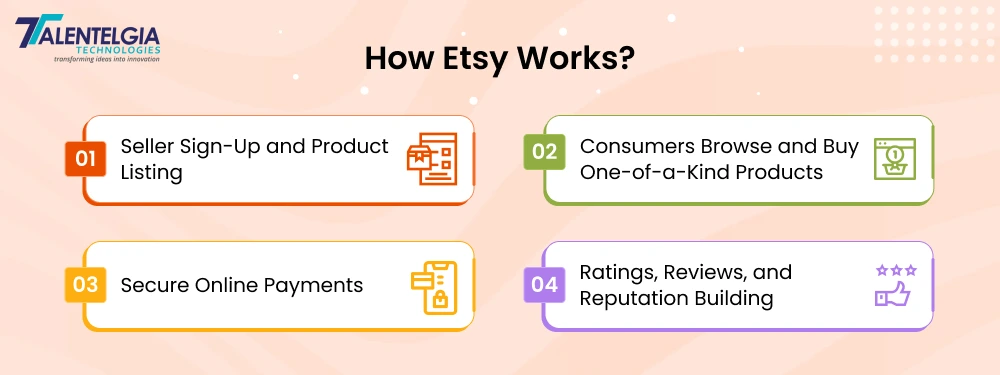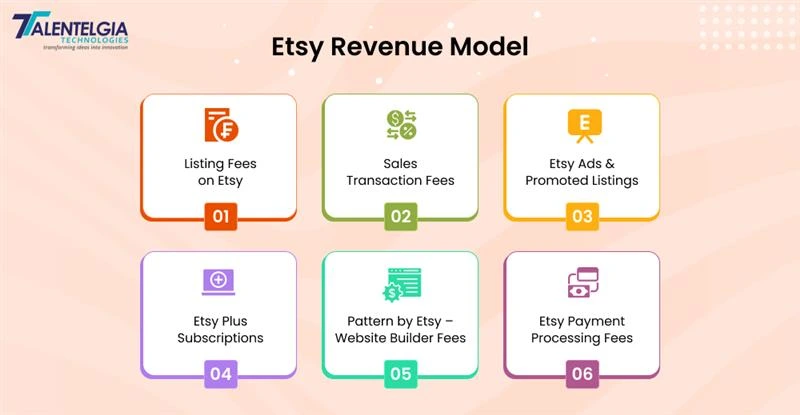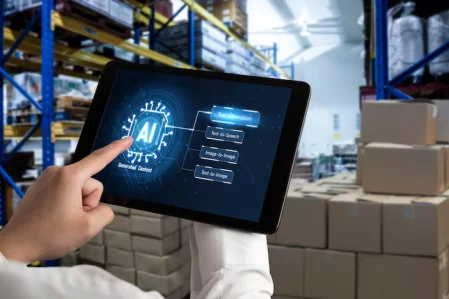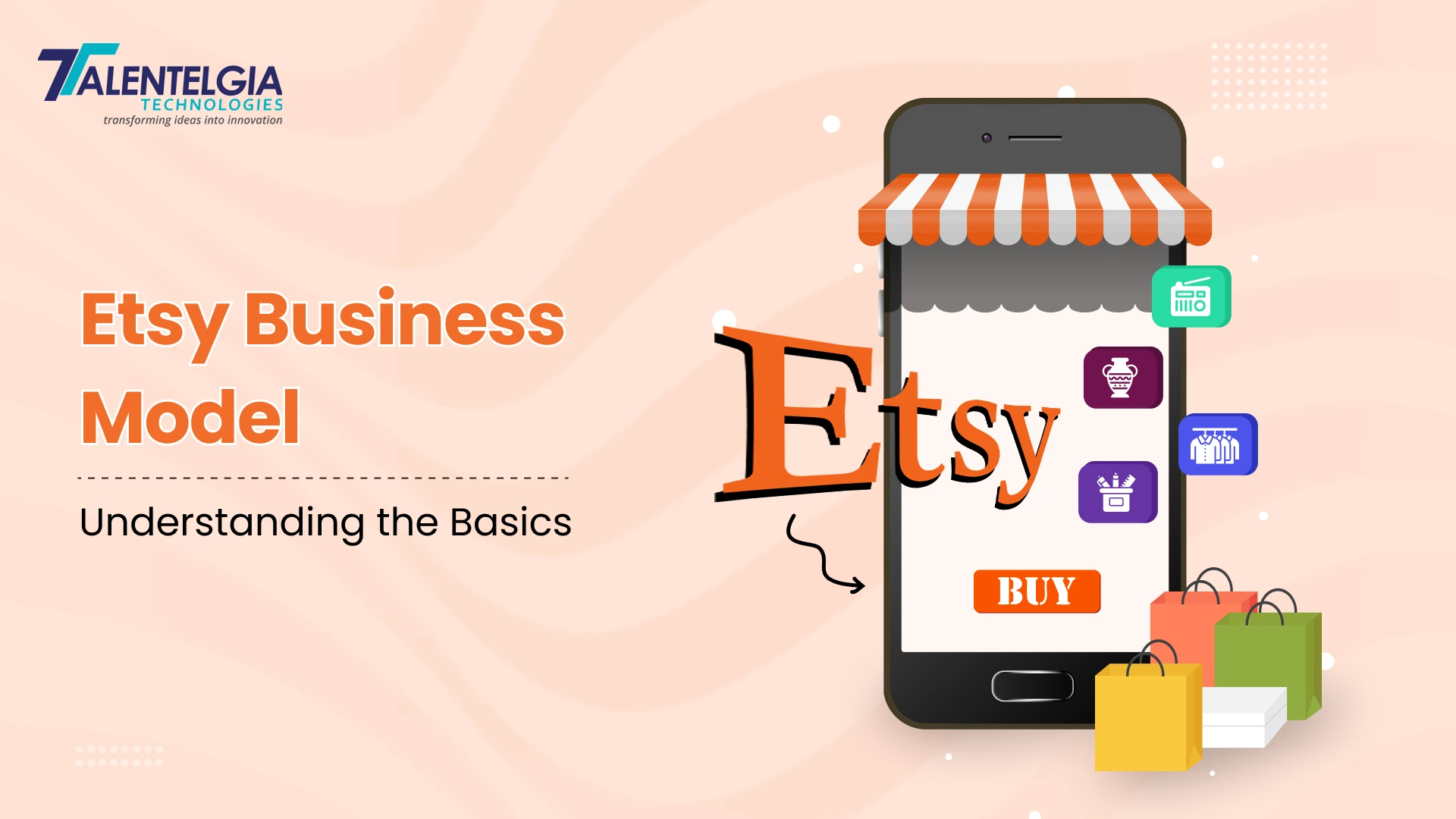Etsy is now a premier marketplace for one-of-a-kind, vintage, and handmade products. It links over 89.6 million active consumers with over 5.6 million vendors. In 2024, Etsy recorded $12.6 billion in gross market value (GMV). Though faced with difficulties in certain sectors, Etsy’s Q1 2025 revenue rose to $651.2 million, demonstrating resilience. The company’s niche orientation, community-oriented culture, and capacity for authentic product curation fuel its success.
In this blog, we will delve into Etsy’s business model in 2025. We will examine its sources of revenue, growth plans, and technological progress. You will discover how Etsy empowers creative entrepreneurs and welcomes tech enthusiasts.
What Is Etsy?
Etsy is an online marketplace that connects buyers and sellers of unique, handmade, vintage, and craft-related goods. Etsy brings together millions of buyers and independent sellers who infuse every order with a personal touch.
At its essence, Etsy is designed to maintain commerce as humans. In a time when automation rules online shopping, Etsy prioritizes people. It enables small business owners, makers, and creatives to turn their passions into profit by providing tools, resources, and low barriers to entry, beginning at only $0.20 per listing.
Whether you’re a buyer seeking something special or a seller wanting to expand your creative business, Etsy provides a safe, community-based environment. With carefully edited collections, robust seller support, and integrated protection policies, it’s a site where inspiration and trust thrive.
Etsy’s History
Etsy’s beginnings were in 2005, when Rob Kalin, then a part-time construction worker and former bookseller, joined up with his pals Chris Maguire and Haim Schoppik to build something that would let artists and craftspeople sell online what they used to make with their own two hands. Stymied by the paucity of resources out there, the three partners started Etsy out of a little Brooklyn apartment and envisioned a healthy online marketplace specializing in creative businesses and women.
In only two years, Etsy experienced explosive growth, having almost 450,000 registered sellers and making $26 million in yearly sales by 2007. In that same year, the company raised over $3 million in venture capital to support its growth. But big changes came in 2008: both Maguire and Schoppik departed from the company, and Maria Thomas was hired as Etsy’s first non-founder CEO. Chad Dickerson, previously at Yahoo, came aboard as Chief Technology Officer and started building out the engineering team to keep pace with Etsy’s expanding user base.
By 2011, Dickerson replaced Thomas as CEO. In his leadership, Etsy raised $40 million in funding in 2012 and grew its presence into international markets. The highlight came in 2013 when Etsy permitted some manufacturers to join with sellers, a move that ignited controversy among its users but ultimately provided opportunities for scalability and business expansion.
Strategic recruits such as Mike Grishaver at Pandora guided Etsy’s mobile-commerce transition, matching changing user trends. In the years that followed, Etsy also made complementary company acquisitions to augment its market strength and platform ability.
In 2015, Etsy made its debut on the global financial landscape with an IPO that generated $237 million—its first entry as a public company. Now, Etsy has more than 4 million innovative sellers living and breathing in its community and reaches more than 80 million active buyers across the globe, demonstrating how a niche concept can grow to become a worldwide e-commerce giant.
Let’s look at some of its milestones:
| Year | Milestone |
|---|---|
| Year | Milestone |
| 2005 | Founded in Brooklyn as a marketplace for handmade goods. |
| 2007 | Reached 1M users. |
| 2011 | Expanded internationally. |
| 2015 | Went public on NASDAQ, raised $267M. |
| 2018 | Acquired Reverb to diversify offerings. |
| 2020 | Saw record sales during the pandemic. |
How Does Etsy Work?
Etsy is a global marketplace created specifically for innovative business owners and selective consumers who desire unique treasures. Its foundation lies in a 4-step model, created specifically to make sellers and buyers equally happy with a win-win experience.
Whether you’re an artist looking to reach millions or a buyer searching for something truly unique, Etsy’s process is simple, intuitive, and user-friendly. Here’s how the Etsy business model works step by step:

Step 1: Seller Sign-Up and Product Listing
The first step involves opening an account on the platform. This registration is required to open access to the selling features of the platform. Etsy provides an easy avenue for makers, small entrepreneurs, and artisans to open a shop and begin selling their wares.
- There is a small listing fee charged (currently $0.20 per listing) that lasts for 4 months.
- Sellers can list handcrafted goods, vintage items (at least 20 years old), or craft supplies.
- After listing, the products are brought to life before Etsy’s worldwide buyer base.
This process allows sellers to monetize their imagination as a successful business without having to develop an entire eCommerce application from ground zero.
Step 2: Consumers Browse and Buy One-of-a-Kind Products
Consumers on Etsy are looking for uniqueness, like custom jewelry such as Swarovski earrings , vintage apparel, hand-poured candles, or hand-stitched notebooks.
- Etsy’s search filters, categories, and personalized suggestions make product discovery easy.
- Shoppers can browse through hundreds of categories and curated collections before they buy.
- Each product has a story behind it, and each purchase supports a solo maker.
This phase highlights Etsy’s value proposition—providing hard-to-find products (if not impossible) to find in brick-and-mortar stores or other websites.
Step 3: Secure Online Payments
At the time of purchase, Etsy provides secure and convenient payment methods through its reliable payment system, Etsy Payments.
- Accepted payment methods include major credit cards, debit cards, bank transfers, PayPal, Etsy Gift Cards, and more.
- The platform manages transactions from start to finish, ensuring buyers’ and sellers’ peace of mind.
- Support for multiple currencies enables worldwide users to shop and pay comfortably.
This move ensures seamless checkout, which raises buyers’ confidence and conversion rates for vendors.
Step 4: Ratings, Reviews, and Reputation Building
Once purchased, consumers can post honest reviews and star ratings for the seller and product.
- This review system creates transparency, assists consumers in making well-informed purchasing decisions, and promotes seller responsibility.
- For sellers, excellent reviews are a great marketing tool, assisting in establishing credibility and gaining visibility.
- Etsy leverages this consumer-generated content to boost search rankings, displaying highly rated products more visibly.
It’s a positive feedback loop—happy consumers post good reviews, which subsequently bring new buyers and enable sellers to expand.
How Etsy Makes Money?
If you’re curious how Etsy maintains its creative marketplace afloat while allowing small businesses to flourish, the secret is through a clever and diversified revenue model. Etsy derives revenue from a combination of listing fees, transaction commissions, ad services, subscriptions, and beyond. Here’s a step-by-step explanation of how Etsy derives revenue from its international community of buyers and sellers.

1. Listing Fees on Etsy
Each time a vendor lists an item in their Etsy store, they incur a listing fee of $0.20 per item. The small fee may not appear significant at first, but with thousands of new listings being added every day, it becomes a consistent source of income for Etsy.
- Listings are active for four months or until the item sells.
- If you post more than one quantity of the same item, Etsy auto-renews the listing and charges another $0.20 per item sold.
- Pattern-only listings (from Etsy’s website builder) don’t expire.
SEO Tip: Etsy listing fees are an ongoing expense that allows Etsy to monetize its marketplace without initial commission reliance.
2. Sales Transaction Fees
When something sells on Etsy, the site charges a 6.5% transaction fee on the entire item price (shipping and gift wrapping included). This is one of Etsy’s biggest sources of revenue.
- The fee is deducted from the total amount paid by the buyer.
- The sellers ought to include this commission in their pricing plan.
This model only makes Etsy money when sellers sell something, making the alignment a win-win.
3. Etsy Ads & Promoted Listings
Etsy provides various advertisement choices that enable sellers to increase their exposure, which makes it an influential income driver.
Ad types:
- Etsy Ads (Onsite Ads): They are cost-per-click (CPC) ads that assist sellers in promoting products in Etsy’s marketplace.
- Offsite Ads: Etsy also conducts outside ads on platforms such as Google Shopping, Bing, Facebook, etc. Sellers only pay when the sale is made through those ads.
SEO Tip: Etsy advertisements bring in higher traffic and conversions, as well as ad income for the website.
4. Etsy Plus Subscriptions
To enable shop expansion, Etsy provides an optional Etsy Plus plan at $10/month. This subscription enables sellers to access more features, including:
- Advanced customization features
- Promotional listing and Etsy Ads credits
- Custom web domains
This subscription model enables Etsy to earn predictable monthly revenue while providing actual value to expanding businesses.
5. Pattern by Etsy – Website Builder Fees
Etsy’s “Pattern” is a website builder where sellers can build independent eCommerce shops beyond Etsy’s marketplace.
- It comes with a 30-day free trial
- Then it is $15/month
This diversifies Etsy’s revenue while enabling sellers to establish their brand presence.
6. Etsy Payment Processing Fees
It offers its payment option called Etsy Payments, through which buyers can pay in:
- Credit/debit cards
- Etsy gift cards
- PayPal
- Apple Pay, Google Pay
- Bank transfers
The Payments sellers pay a payment processing fee based on the amount sold. The fee depends on the country and is deducted from their accounts.
Etsy Operations Model
Etsy operates as a worldwide multi-vendor marketplace in which individual sellers provide handmade, vintage, and craft-related products under categories such as Jewelry, Home & Living, Art, and others. The marketplace enjoys robust global penetration—48% of GMS in Q2 2024 originated outside the U.S., reflecting its cross-border popularity.
Mobile-First User Experience
Etsy continues to observe increasing engagement via mobile, with the Etsy app recording all-time usage in Q1 2025. One of the biggest drivers of this is the firm’s concentration on individualized shopping experiences, such as a new “Shop” discovery tab and AI-based recommendations that maximize user satisfaction and conversion.
Inventory-Free Model Boosts Growth
Unlike conventional retailers, Etsy does not handle or stock inventory. Rather, every product is listed, maintained, and shipped by individual sellers. Etsy’s function is to offer a digital platform, process transactions, and facilitate trust and safety between buyers and sellers. This asset-light business model facilitates easier scalability for Etsy without the supply chain logistics complexities.
Robust Seller & Community Protections
To ensure a high-quality shopping experience, Etsy has strict Community Policies and provides strong Seller Protection Programs. These elements instill confidence and lower the risk for both buyers and sellers, which is important in a marketplace that handles customized and personalized products.
Seasonal Trends and Performance
Etsy is very watchful of seasonal demand and shopper habits. Trends such as custom gifts, home decor, and wedding-related products are likely to experience peaks in holidays and holiday-like events. For instance, during Q1 2024, Etsy’s Gifting category experienced a 4.1% year-over-year increase, beating many peers.
Etsy Marketing Tools & Strategies
Etsy pursues a multi-faceted marketing approach centered on both new buyer acquisition and existing user engagement across digital media. From customized marketing efforts to AI and Gen Z marketing, Etsy’s growth strategies are designed to reach buyers and sellers where they’re at—and return.
1. Paid Advertising and Digital Reach
Etsy continues to invest heavily in paid online advertising, particularly on social media. In Q1 2025, the company also reported a sizeable year-over-year growth in Gross Merchandise Sales (GMS) generated from social ads. Social campaigns on Facebook, Instagram, and Google are particularly important for bringing traffic to the marketplace.
2. Personalized Email and Push Notifications
Etsy is making the experience more interactive with personalized emails and push alerts. Early in 2025, the site sent out more than 10% more tailored marketing messages than it had the year before, enabling buyers to find interesting items based on search and buying history.
3. New Platform Integrations
To be ahead of the curve, Etsy has integrated with next-gen and AI-powered shopping platforms:
- OpenAI Operator: Enables ChatGPT users to shop Etsy through conversational inputs
- Microsoft Copilot: Facilitates easy Etsy purchases across Microsoft applications
These integrations enable Etsy to reach customers in new settings and simplify shopping.
4. Seasonal and Category-Based Campaigns
Etsy executes strategic product and branding campaigns based on top themes such as:
- Home decor
- Holiday gift-giving
- Birthday shopping
- Style refresh seasons
These campaigns drive buyer frequency and focus on high-intent categories with high conversion potential.
5. Mobile Application and Loyalty Programs
The Etsy mobile application remains a high priority. Enhancements to performance and user experience late last year furthered the cause. Meanwhile, Etsy is testing a new loyalty program, “Etsy Insider,” in closed beta. The rewards program provides such perks as:
- Member-exclusive discounts
- Third-party offers are exclusive to members
- Potential future opportunities for subscription-based perks
The goal is to promote higher buyer retention and lifetime value.
6. Cross-Promotion and Acquisition of Sellers
Etsy sells not just to consumers but also acquires sellers as well. Methods employed include:
- Pay-per-click ads that target small business owners and maker types
- Natural SEO through queries like “start a craft business”
- Highlighting success stories among sellers and guideposts
Keeping the sellers buying paid options when they’ve registered on the platform provides a loop for site monetization.
Conclusion
Etsy has established a robust niche in e-commerce by holding fast to the things that distinguish it: community, creativity, and authenticity. In 2025, Etsy will remain not only a successful marketplace but also a platform that activates millions of self-sufficient creatives globally. Its diversified business model—from ad services and transactions to listing fees and subscription offerings—demonstrates not only sustainability but also scalability.
What distinguishes Etsy is how it can marry technology with humanity. While it leverages the strengths of AI and digital tools to improve user experience and international reach, it never compromises its purpose: keeping commerce human. Whether you're a maker who wants to turn your passion into a business or an investor monitoring Etsy's trajectory of innovation, one thing is certain—Etsy isn't selling products; it's selling purpose, personality, and possibility.
As Etsy continues to grow, it is a beacon of hope for how today's platforms can expand responsibly without losing sight of values that matter.


 Healthcare App Development Services
Healthcare App Development Services
 Real Estate Web Development Services
Real Estate Web Development Services
 E-Commerce App Development Services
E-Commerce App Development Services E-Commerce Web Development Services
E-Commerce Web Development Services Blockchain E-commerce Development Company
Blockchain E-commerce Development Company
 Fintech App Development Services
Fintech App Development Services Fintech Web Development
Fintech Web Development Blockchain Fintech Development Company
Blockchain Fintech Development Company
 E-Learning App Development Services
E-Learning App Development Services
 Restaurant App Development Company
Restaurant App Development Company
 Mobile Game Development Company
Mobile Game Development Company
 Travel App Development Company
Travel App Development Company
 Automotive Web Design
Automotive Web Design
 AI Traffic Management System
AI Traffic Management System
 AI Inventory Management Software
AI Inventory Management Software
 AI Software Development
AI Software Development  AI Development Company
AI Development Company  AI App Development Services
AI App Development Services  ChatGPT integration services
ChatGPT integration services  AI Integration Services
AI Integration Services  Generative AI Development Services
Generative AI Development Services  Natural Language Processing Company
Natural Language Processing Company Machine Learning Development
Machine Learning Development  Machine learning consulting services
Machine learning consulting services  Blockchain Development
Blockchain Development  Blockchain Software Development
Blockchain Software Development  Smart Contract Development Company
Smart Contract Development Company  NFT Marketplace Development Services
NFT Marketplace Development Services  Asset Tokenization Company
Asset Tokenization Company DeFi Wallet Development Company
DeFi Wallet Development Company Mobile App Development
Mobile App Development  IOS App Development
IOS App Development  Android App Development
Android App Development  Cross-Platform App Development
Cross-Platform App Development  Augmented Reality (AR) App Development
Augmented Reality (AR) App Development  Virtual Reality (VR) App Development
Virtual Reality (VR) App Development  Web App Development
Web App Development  SaaS App Development
SaaS App Development Flutter
Flutter  React Native
React Native  Swift (IOS)
Swift (IOS)  Kotlin (Android)
Kotlin (Android)  Mean Stack Development
Mean Stack Development  AngularJS Development
AngularJS Development  MongoDB Development
MongoDB Development  Nodejs Development
Nodejs Development  Database Development
Database Development Ruby on Rails Development
Ruby on Rails Development Expressjs Development
Expressjs Development  Full Stack Development
Full Stack Development  Web Development Services
Web Development Services  Laravel Development
Laravel Development  LAMP Development
LAMP Development  Custom PHP Development
Custom PHP Development  .Net Development
.Net Development  User Experience Design Services
User Experience Design Services  User Interface Design Services
User Interface Design Services  Automated Testing
Automated Testing  Manual Testing
Manual Testing  Digital Marketing Services
Digital Marketing Services 
 Ride-Sharing And Taxi Services
Ride-Sharing And Taxi Services Food Delivery Services
Food Delivery Services Grocery Delivery Services
Grocery Delivery Services Transportation And Logistics
Transportation And Logistics Car Wash App
Car Wash App Home Services App
Home Services App ERP Development Services
ERP Development Services CMS Development Services
CMS Development Services LMS Development
LMS Development CRM Development
CRM Development DevOps Development Services
DevOps Development Services AI Business Solutions
AI Business Solutions AI Cloud Solutions
AI Cloud Solutions AI Chatbot Development
AI Chatbot Development API Development
API Development Blockchain Product Development
Blockchain Product Development Cryptocurrency Wallet Development
Cryptocurrency Wallet Development About Talentelgia
About Talentelgia  Our Team
Our Team  Our Culture
Our Culture 
 Healthcare App Development Services
Healthcare App Development Services Real Estate Web Development Services
Real Estate Web Development Services E-Commerce App Development Services
E-Commerce App Development Services E-Commerce Web Development Services
E-Commerce Web Development Services Blockchain E-commerce
Development Company
Blockchain E-commerce
Development Company Fintech App Development Services
Fintech App Development Services Finance Web Development
Finance Web Development Blockchain Fintech
Development Company
Blockchain Fintech
Development Company E-Learning App Development Services
E-Learning App Development Services Restaurant App Development Company
Restaurant App Development Company Mobile Game Development Company
Mobile Game Development Company Travel App Development Company
Travel App Development Company Automotive Web Design
Automotive Web Design AI Traffic Management System
AI Traffic Management System AI Inventory Management Software
AI Inventory Management Software AI Software Development
AI Software Development AI Development Company
AI Development Company ChatGPT integration services
ChatGPT integration services AI Integration Services
AI Integration Services Machine Learning Development
Machine Learning Development Machine learning consulting services
Machine learning consulting services Blockchain Development
Blockchain Development Blockchain Software Development
Blockchain Software Development Smart contract development company
Smart contract development company NFT marketplace development services
NFT marketplace development services IOS App Development
IOS App Development Android App Development
Android App Development Cross-Platform App Development
Cross-Platform App Development Augmented Reality (AR) App
Development
Augmented Reality (AR) App
Development Virtual Reality (VR) App Development
Virtual Reality (VR) App Development Web App Development
Web App Development Flutter
Flutter React
Native
React
Native Swift
(IOS)
Swift
(IOS) Kotlin (Android)
Kotlin (Android) MEAN Stack Development
MEAN Stack Development AngularJS Development
AngularJS Development MongoDB Development
MongoDB Development Nodejs Development
Nodejs Development Database development services
Database development services Ruby on Rails Development services
Ruby on Rails Development services Expressjs Development
Expressjs Development Full Stack Development
Full Stack Development Web Development Services
Web Development Services Laravel Development
Laravel Development LAMP
Development
LAMP
Development Custom PHP Development
Custom PHP Development User Experience Design Services
User Experience Design Services User Interface Design Services
User Interface Design Services Automated Testing
Automated Testing Manual
Testing
Manual
Testing About Talentelgia
About Talentelgia Our Team
Our Team Our Culture
Our Culture


















 Write us on:
Write us on:  Business queries:
Business queries:  HR:
HR: 




